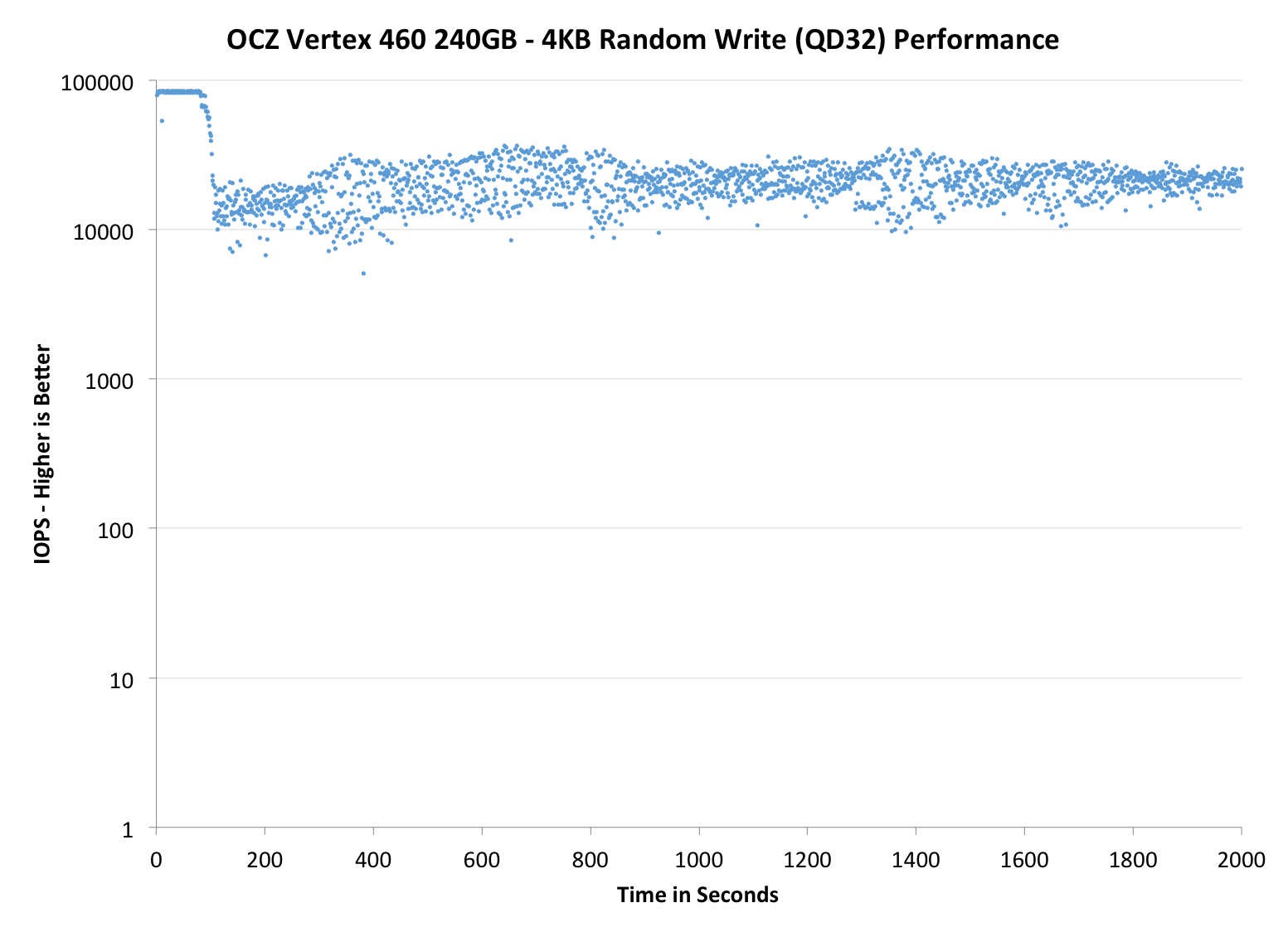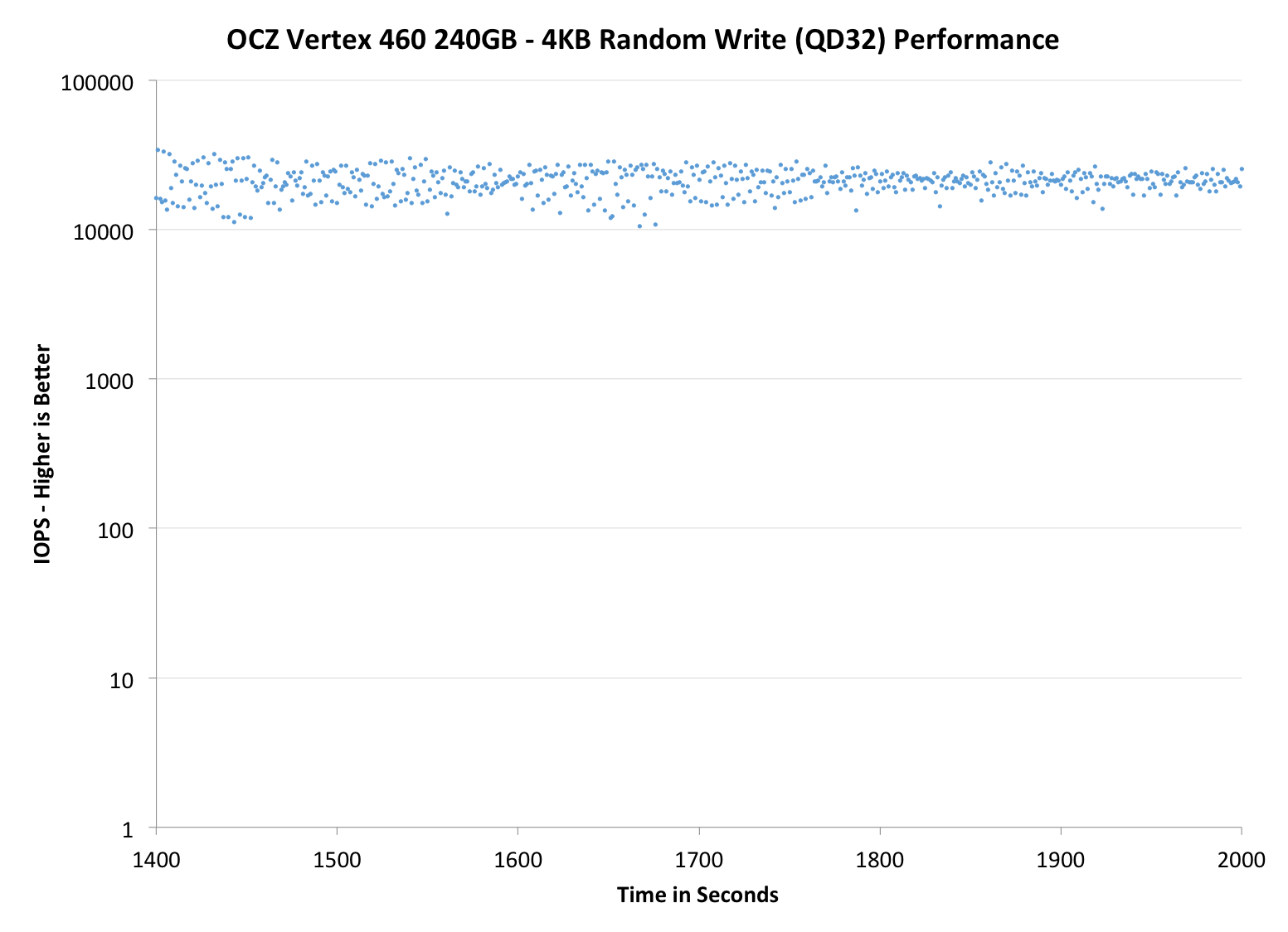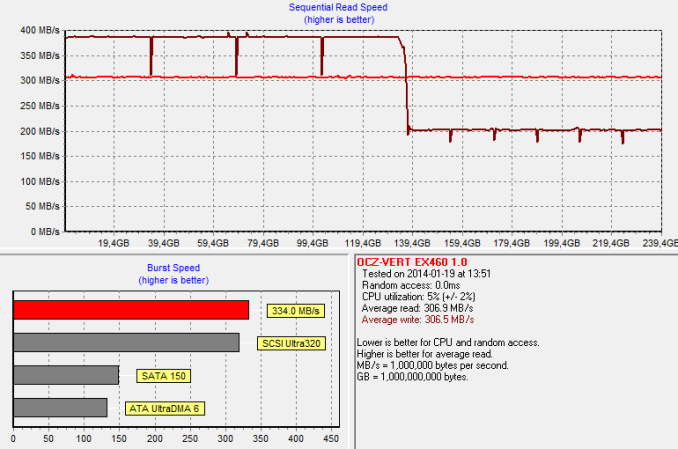OCZ Vertex 460 (240GB) Review
by Kristian Vättö on January 22, 2014 9:00 AM EST- Posted in
- Storage
- SSDs
- OCZ
- Indilinx
- Vertex 460
Performance Consistency
In our Intel SSD DC S3700 review Anand introduced a new method of characterizing performance: looking at the latency of individual operations over time. The S3700 promised a level of performance consistency that was unmatched in the industry, and as a result needed some additional testing to show that. The reason we don't have consistent IO latency with SSDs is because inevitably all controllers have to do some amount of defragmentation or garbage collection in order to continue operating at high speeds. When and how an SSD decides to run its defrag and cleanup routines directly impacts the user experience. Frequent (borderline aggressive) cleanup generally results in more stable performance, while delaying that can result in higher peak performance at the expense of much lower worst-case performance. The graphs below tell us a lot about the architecture of these SSDs and how they handle internal defragmentation.
To generate the data below we take a freshly secure erased SSD and fill it with sequential data. This ensures that all user accessible LBAs have data associated with them. Next we kick off a 4KB random write workload across all LBAs at a queue depth of 32 using incompressible data. We run the test for just over half an hour, nowhere near what we run our steady state tests for but enough to give a good look at drive behavior once all spare area fills up.
We record instantaneous IOPS every second for the duration of the test and then plot IOPS vs. time and generate the scatter plots below. Each set of graphs features the same scale. The first two sets use a log scale for easy comparison, while the last set of graphs uses a linear scale that tops out at 40K IOPS for better visualization of differences between drives.
The high level testing methodology remains unchanged from our S3700 review. Unlike in previous reviews however, we vary the percentage of the drive that gets filled/tested depending on the amount of spare area we're trying to simulate. The buttons are labeled with the advertised user capacity had the SSD vendor decided to use that specific amount of spare area. If you want to replicate this on your own all you need to do is create a partition smaller than the total capacity of the drive and leave the remaining space unused to simulate a larger amount of spare area. The partitioning step isn't absolutely necessary in every case but it's an easy way to make sure you never exceed your allocated spare area. It's a good idea to do this from the start (e.g. secure erase, partition, then install Windows), but if you are working backwards you can always create the spare area partition, format it to TRIM it, then delete the partition. Finally, this method of creating spare area works on the drives we've tested here but not all controllers are guaranteed to behave the same way.
The first set of graphs shows the performance data over the entire 2000 second test period. In these charts you'll notice an early period of very high performance followed by a sharp dropoff. What you're seeing in that case is the drive allocating new blocks from its spare area, then eventually using up all free blocks and having to perform a read-modify-write for all subsequent writes (write amplification goes up, performance goes down).
The second set of graphs zooms in to the beginning of steady state operation for the drive (t=1400s). The third set also looks at the beginning of steady state operation but on a linear performance scale. Click the buttons below each graph to switch source data.
 |
|||||||||
| OCZ Vertex 460 240GB | OCZ Vector 150 240GB | Corsair Neutron 240GB | Sandisk Extreme II 480GB | Samsung SSD 840 Pro 256GB | |||||
| Default | |||||||||
| 25% OP | |||||||||
Performance consistency is more or less a match with the Vector 150. There is essentially no difference, only some slight variation which may as well be caused by the nature of how garbage collection algorithms work (i.e. the result is never exactly the same).
 |
|||||||||
| OCZ Vertex 460 240GB | OCZ Vector 150 240GB | Corsair Neutron 240GB | SanDisk Extreme II 480GB | Samsung SSD 840 Pro 256GB | |||||
| Default | |||||||||
| 25% OP | |||||||||
 |
|||||||||
| OCZ Vertex 460 240GB | OCZ Vector 150 240GB | Corsair Neutron 240GB | SanDisk Extreme II 480GB | Samsung SSD 840 Pro 256GB | |||||
| Default | |||||||||
| 25% OP | |||||||||
TRIM Validation
To test TRIM, I first filled all user-accessible LBAs with sequential data and continued with torturing the drive with 4KB random writes (100% LBA, QD=32) for 60 minutes. After the torture I TRIM'ed the drive (quick format in Windows 7/8) and ran HD Tach to make sure TRIM is functional.
And TRIM works. The HD Tach graph also shows the impact of OCZ's performance mode, although in a negative light. Once half of the LBAs have been filled, all data has to be reorganized. The result is a decrease in write performance as the drive is reorganizing the existing data at the same time as HD Tach is writing to it. Once the reorganization process is over, the performance will recover close to the original performance.











69 Comments
View All Comments
jragonsoul - Wednesday, January 22, 2014 - link
But they really aren't, OCZ is still OCZ and they are still making their own drives. I see that as a smart move by them because if Toshiba would have swallowed the company and they made some SSD's I know at least me and my tech friends would have stayed well and far away until EXTENSIVE reviews appeared.AssBall - Wednesday, January 22, 2014 - link
OCZ had a bad run of drives and couldn't get it fixed. Years before that, they made excellent memory, and good PSU's. Their early SSD's were pretty good too. Being hung up on their screw up sounds like you can't get over personal issues. They will come back and be profitable again. Toshiba will help right the ship.Samus - Wednesday, January 22, 2014 - link
Yep. Let's not forget those poor early adopters of MacBook Air's that were unlucky enough to end up with a Toshiba drive instead of a Samsung (Apple was using both vendors through production, so it was luck of the draw)Needless to say Apple doesn't use Toshiba SSD's much anymore, even with their bitterness with Samsung.
lmcd - Thursday, January 23, 2014 - link
"Much."So?
DarkStryke - Wednesday, January 22, 2014 - link
You have some pretty nice revisionist history there. Take your own advice and learn about the history of OCZ, especially before the company incorporated under that title.I hear the overclockerz store had great customer service too!
Once a fool..
GTVic - Thursday, January 23, 2014 - link
My OCZ power supply died precisely after the warranty expired.random2 - Sunday, February 2, 2014 - link
You cannot blame a person for feeling that the OCZ name is a deterrent. Doesn't even have to be personal to want to see people avoid product that has not been good for years, hasn't been good through numerous models of drives, and has casued a great many people a lot of heart ache and frustration. All becasue OCZ couldn't bring themselves to make sure their product was viable and market ready BEFORE it went out their door.http://www.behardware.com/articles/881-7/component...
Go ahead....buy an OCZ drive.
AMRAAM_Missiles - Thursday, March 20, 2014 - link
Eventhough you make sense, that the company has a dark area which it lost the trust from a lot of people, it doesn't mean that it won't get better.My first ever SSD was the Vertex 4 from OCZ, and guess what, it is still regarded as one of the best Performance SSD that money could buy today. 3 solid years of grinding the OS with constants write and read, it shows no drop in performance. I am not saying that failures are not real, but it doesn't go the extend that people make it out to be.
Now, i have just bought another Vector and Vector 150 for my rig, and i couldn't be more happier with a role of a normal consumer and an enthusiast of PC in general. Sometime, people just have to hate for the sake of hating without even trying to open their eyes to verify the current situation a little bit.
JDG1980 - Wednesday, January 22, 2014 - link
That was my thought, as well. The purchase of OCZ made sense, because they have some decent controller IP and Toshiba wasn't too strong in that area, but the OCZ name is dirt because of their horrendous record of reliability, so I have no idea why they wanted to keep that.Samus - Wednesday, January 22, 2014 - link
I remember an interview Anand posted years ago with the CEO of OCZ, and Anand was pretty adamant about them ditching their name (for obvious reasons) and the CEO said they were going to keep it. That didn't work out so great for them. I don't see it working for Toshiba, either. They need to ditch the name and come up with another one, or just call it Toshiba.